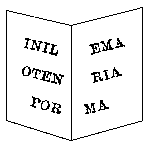IX. SANCTUS, SANCTUS, SANCTUS 311
faces with their robes; at its foot lies a skull,-Golgotha,-upon which falls the blood from Christ’s feet, whilst on each side of the Saviour are five figures, those at the extreme ends of the mosaic being a doge and dogaress, probably the donors.1
To the left is St. 
To the right of the cross is St. John the Evangelist-S. IOHES EVG-his face covered with his hands, receiving charge of the Virgin: “When Jesus, therefore, saw his mother, and the disciple standing by, whom he loved, he saith unto his mother, Woman, behold thy son! Then saith he to the disciple, Behold thy mother! And from that hour the disciple took her unto his own home” (St. John xix. 26, 27).
Lastly, next St. John the Evangelist is St. John the Baptist, bearing a scroll, on which are the words:
“ECCE AGNUS DEI ECE ...”
“Ecce agnus Dei, ecce qui tollit peccatum mundi.”
“Behold the Lamb of God which taketh away the sin of the world” (St. John i. 29).*
* The scriptural references in this appendix are, first, to the Vulgate, which most of the legends in the Baptistery follow, and, secondly, to the English version of the Bible. The visitor will also notice that throughout the chapel the scrolls are constantly treated by the mosaicists literally as scrolls, the text being cut short even in the middle of a word by the curl of the supposed parchment.
1 [On Christ’s left hand are John the Evangelist and John the Baptist (with a scroll on which is the text John i. 29); at the foot of the cross kneels the Doge, Andrea Dandolo, and at the extreme ends, not a doge and dogaress, but the doge’s Grand Chancellor, Rafaino Caresini (Boito, p. 803), and a Senator.]
2 [See above, § 57, p. 252.]
[Version 0.04: March 2008]